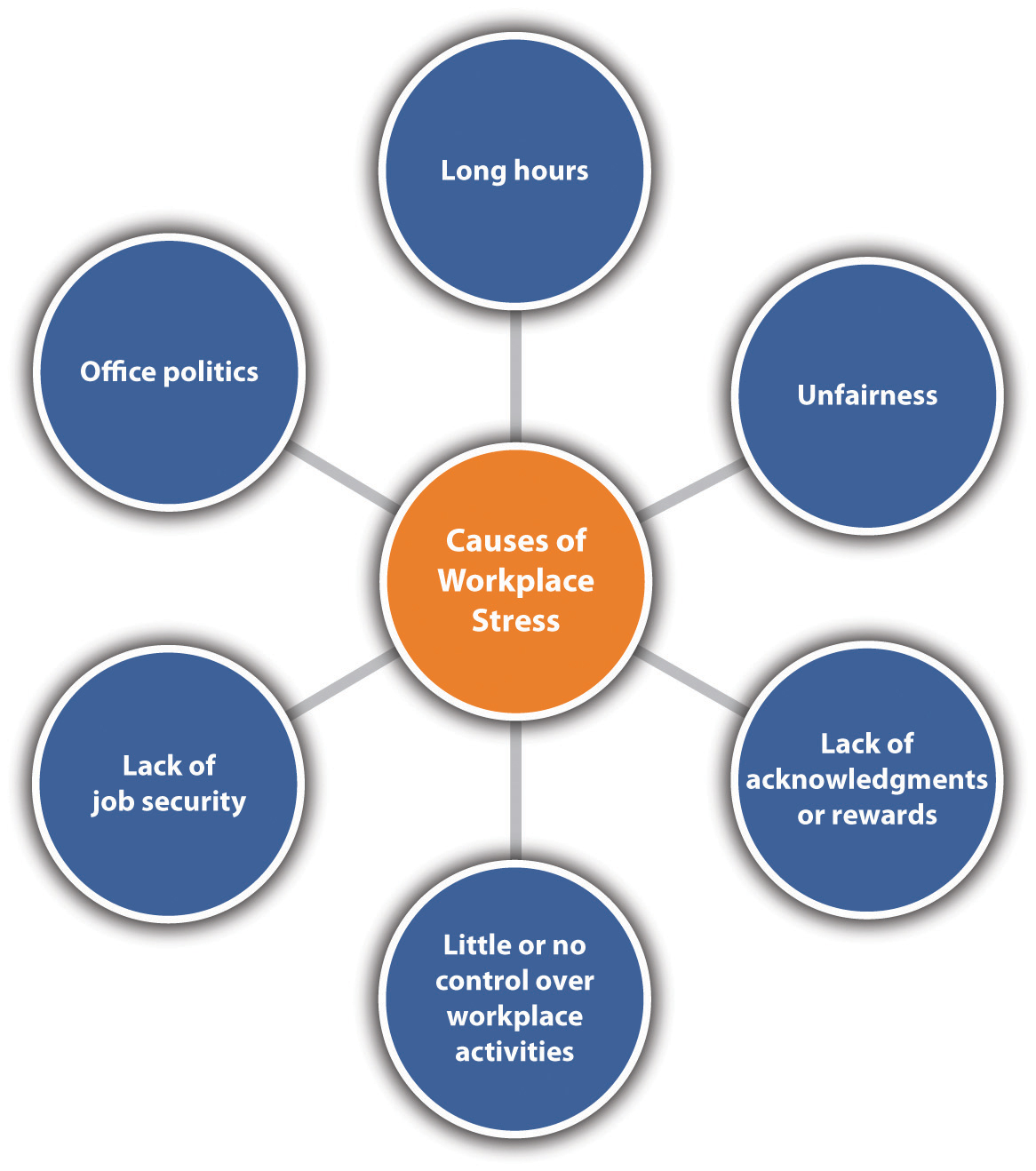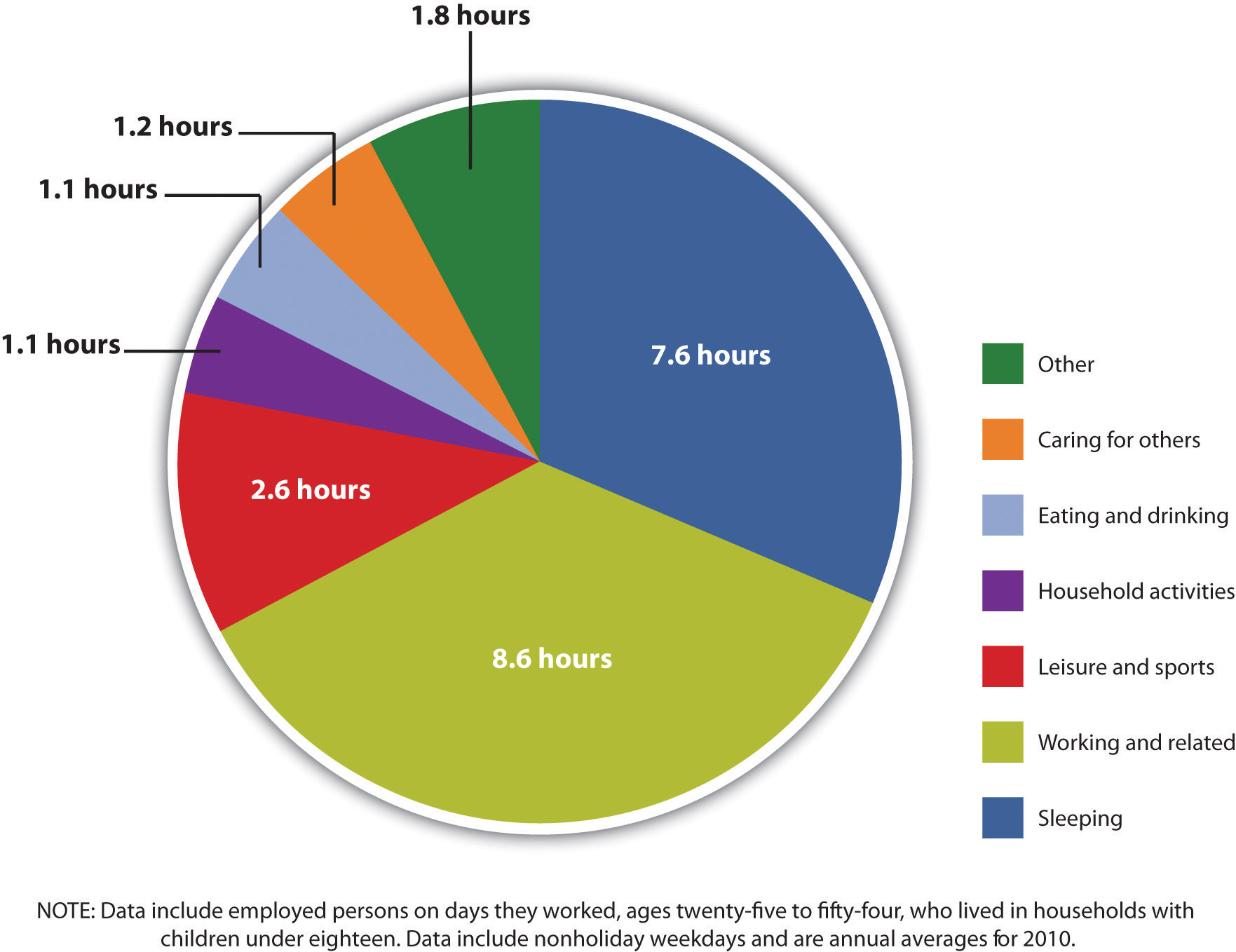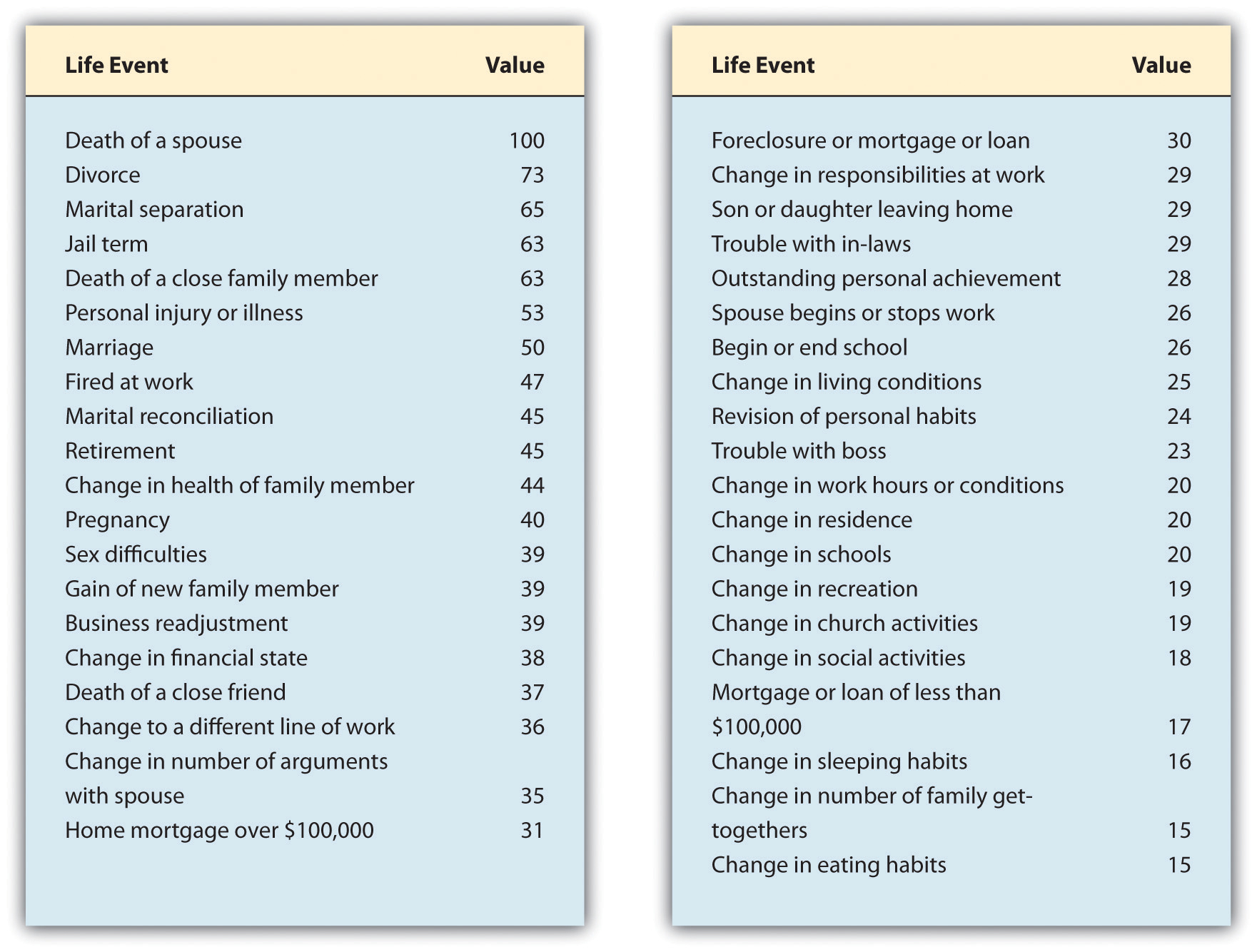3.4: Sources of Stress
- Last updated
- Save as PDF
- Page ID
- 15493

- Anonymous
- LibreTexts
learning objective
- Explain the sources of stress we can experience, both personally and professionally.
Work Stress
As we have studied so far in this chapter, we can experience a number of possible stressors. We can divide these stressors into personal stresses and work stresses. Although we divide them for purposes of ease, it is intuitive that if someone is experiencing personal stress, he or she will also experience it at work, which will result in lessened workplace performance. In fact, the American Institute of Stress estimates that workplace stress costs companies $300 billion annually. This cost is a result of increased absenteeism, employee turnover, and higher medical and insurance costs due to stress related illness and worker productivity.[1]
According to the American Institute of Stress,[2] some of the common causes of workplace stress include the following:
- Long hours and increased demands. The average American works forty-six hours per week.[3] Much of this is due to increased technology and expectations that employees will be available to answer e-mail on weekends and evenings. As a result of this added work time, employees find less time to engage in leisure and household activities such as grocery shopping and cleaning.
- Being treated unfairly. Workplace issues such as harassment and bullying (both discussed in Chapter 10) can cause people to feel stress at work. Additional issues, such as feeling overlooked for promotions, can also cause workplace stress. In extreme cases, perceived workplace unfairness can result in violence. For example, Matthew Beck shot and killed four supervisors in a Connecticut lottery office because he felt he had been unfairly overlooked for a promotion.[4] Many organizations offer Employee Assistance Programs that can offer services, such as counseling, to help deal with workplace stress and other personal issues.
- Little or no acknowledgment or reward. People can feel stress when they do not feel they are being recognized for the work they do. This kind of workplace stress can cause people to become withdrawn, unmotivated, or unfocused on being productive for the organization. This type of behavior can also materialize at home with people experiencing this stress being more irritable, cranky, and moody. At work, these feelings can negatively affect our ability to relate to our coworkers and manager.
- Lack of control. Micromanagement refers to excessive control of work details by a supervisor. For example, a micromanager might tell an employee specific tasks should be worked on in a given day and give specific instructions on how those tasks should be accomplished. This type of situation can create stress, as the employee feels he or she has little control of their own work.
- Lack of job security. In the last quarter of 2011 (October, November, December), 266,971 employees were subjected to mass company layoffs,[5] and for obvious reasons, this creates stress upon the workers who had to leave and for those workers who stay. Those workers who have been laid off may experience financial hardship, and the workers who haven’t been laid off may need to perform extra work and can suffer from physiological issues even if their jobs were not eliminated. This phenomenon is called layoff survivor syndrome.[6] Many of the stressors caused by layoffs can include increased workloads, increased anxiety, and lower morale.
- Office politics. Dealing with difficult coworkers or supervisors and different personalities (Chapter 9) and communication styles (Chapter 4) can create stress at work. Conflicts, disagreements, and misunderstandings are common in today’s workplace, especially with the use of technology. All of these factors, which we call office politics, can create stress, which results in lost sleep, productivity, and motivation—obviously affecting our ability to relate to others.

work stress management
Video \(\PageIndex{1}\): https://www.youtube.com/watch?v=7oQWsjNNSR4
Registered clinical psychologist Dr. Cheryl talks about some ways to manage stress at work.

Data from the Bureau of Labor Statistics shows how much time we spend at work. Since we spend more time at work than doing anything else, learning how to manage stress at work is an important part to our personal well-being and productivity.
Personal Stress
While job stress is important to consider, stresses in our personal life can cause issues in our job. In this section, we will discuss some of the major personal stressors.
- Everyday challenges. Getting caught in traffic or a leaky water heater would be examples of things that cause stress in our personal lives. Luckily, most of us have the abilities to cope with these daily stresses. However, too many of these types of stressors in one day can build up and cause major issues at work or in our personal life.
- Personality. Our individual personalities (Chapter 1) can impact our ability to handle stress. Research published by Meyer Freidman in the 1950s[7] characterized two main personality types, type A and type B. People with a type A personality tend to be more time conscious, impatient, and preoccupied with tasks. A Type A Behavior Pattern (TABP) is characterized by impatience, aggressiveness, a sense of time urgency, and the desire to achieve recognition and advancement. People with a type A pattern may have a hyperawareness of time and, as a result, perform tasks quickly. Because of these patterns, the person with TABP may feel constantly rushed as they strive to be constantly competitive, causing stress and related health issues. Type A personalities are not viewed as a fixed trait but rather a set of predispositions that may occur in certain situations only. For example, Amiee may exhibit a type A personality at work, but at home may not be as time sensitive and impatient. Type B personalities are more focused on the here and now and are much more laid back. Type B personalities do not normally experience as much stress as their type A counterparts because their viewpoint on time and achievement is different.
type A personality and stress
Video \(\PageIndex{2}\): https://www.youtube.com/watch?v=leZUJzRNe30
A humorous (and exaggerated) example of stress caused by type A personality.
- Work-life balance. Everyone must manage multiple roles in their life. The roles of mother or father, boss, employee, spouse, sister, or brother have their own unique demands that can create stress at home and at work. When we have challenges at work, this can affect our roles at home and vice versa. Although many organizations promote a work-life balance and create a culture that allows people to have a “home life,” easy access to send that “one last e-mail” at 9 p.m. for work creates a blurred line between home and work. This creates an even greater need for our emotional intelligence skills (self-awareness and self-management) in that we must be aware of our emotions and handle them when they come—rather than just going about our day and plowing ahead.
- Life changes. There are forty-three life changes that are characterized as creating stress. These life changes are measured on a scale called life change units, created by Thomas H. Holmes and Richard Rahe. The life changes are said to cause stress in one’s personal life. However, personality type and situational factors may affect how much a particular event affects a person. For example, suppose a major life change, such as the death of a spouse occurs. This would cause an immense amount of stress, but assume the spouse was very ill for a long period of time. In this situation, the latter could have caused stress, as well. So while the scale has value in terms of determining what life changes cause the most stress, it is also important to consider the other factors around the life change, along with a person’s personal coping ability.

Thomas H. Holmes and Richard Rahe measured personal stress by Life Change Units. According to their research, the more “major changes” one experiences, the higher the chance a person will end up with a stress-induced illness. Someone with a score of 300 or more is said to be at a high risk of illness.[8] If you look at the events of your life over the last year, what is your score?
- Financial issues. Tough economic times, combined with increasing costs of fuel and other living expenses, create great stress on individuals and families. Not having enough money to buy basic needs and lacking the ability to buy the wants we have can lead to anxiety, tension, and depression. These emotions can carry over into our work life, resulting in lowered productivity and lowered human relations with our coworkers.
- Friends and family issues. Challenges with family, in-laws, and friends create a great source of stress as well. While most of us depend on friends and family for support, tension, and disagreements can cause stress.
Now that we have discussed the things that cause stress, The next section will address some ways we can relieve stress in our lives.
stress quiz: how stressed are you?[9]
Understanding your own stress level is an emotional intelligence skill (self-awareness). Take this quiz, and rate how you typically react in each of the situations listed below.
4 = Always
3 = Frequently
2 = Sometimes
1 = Never
Enter the appropriate number in the blank for each question below, and then add up your numbers to determine your stress level.
- _____ Do you try to do as much as possible in the least amount of time?
- _____ Do you become impatient with delays or interruptions?
- _____ Do you always have to win at games to enjoy yourself?
- _____ Do you find yourself speeding up the car to beat the red light?
- _____ Are you unlikely to ask for or indicate you need help with a problem?
- _____ Do you constantly seek the respect and admiration of others?
- _____ Are you overly critical of the way others do their work?
- _____ Do you have the habit of looking at your watch or clock often?
- _____ Do you constantly strive to better your position and achievements?
- _____ Do you spread yourself “too thin” in terms of your time?
- _____ Do you have the habit of doing more than one thing at a time?
- _____ Do you frequently get angry or irritable?
- _____ Do you have little time for hobbies or time by yourself?
- _____ Do you have a tendency to talk quickly or hasten conversations?
- _____ Do you consider yourself hard-driving?
- _____ Do your friends or relatives consider you hard-driving?
- _____ Do you have a tendency to get involved in multiple projects?
- _____ Do you have a lot of deadlines in your work?
- _____ Do you feel vaguely guilty if you relax and do nothing during leisure?
- _____ Do you take on too many responsibilities?
Total: _____
If your score is between 20 and 30, chances are you are nonproductive, or your life lacks stimulation.
A score between 31 and 50 designates a good balance in your ability to handle and control stress.
If you tallied up a score ranging between 51 and 60, your stress level is marginal, and you are bordering on being excessively tense.
If your total number of points exceeds 60, you may be a candidate for heart disease and need to find ways to relieve your stress immediately.
Source: www.arc.sbc.edu/stressquiz.html
Key Takeaways
- Workplace stress costs companies as much as $300 billion annually. Stress experienced at work can come from higher demands, layoffs, conflicts among coworkers, or office politics.
- Many people also can experience personal stresses, which affect workers’ abilities to be productive. Personal stress can come from life changes, financial issues, family and friend issues, or our personality. Type A personalities tend to experience more stress as a result of their high need for achievement.
Exercises \(\PageIndex{1}\)
- Type A personalities tend to experience more stress than their type B personality counterpart. Take this quiz online at http://cl1.psychtests.com/take_test....idRegTest=2986 to see what type you fall into. How do you think your personality contributes (or not) to stress?
- Do you agree or disagree with this statement? My personality contributes to the amount of stress I have in my life. Please explain in two to four paragraphs.
- The American Institute of Stress, “Stress in the Workplace,” accessed February 19, 2012, http://www.stress.org/workplace-stress/
- The American Institute of Stress, “Stress in the Workplace,” accessed February 19, 2012, http://www.stress.org/workplace-stress/
- The Library Spot, “National Sleep Foundation Study,” accessed February 19, 2012,http://www.libraryspot.com/know/workweek.htm
- Johnathan Rabinnoviz, “Lottery Personnel Shows Lottery Killer Came Back Early from Leave,” New York Times, March 12, 1988, accessed February 19, 2012,www.nytimes.com/1998/03/12/ny...m-a-leave.html? ref=matthewbeck
- The Bureau of Labor Statistics, “Economic News Release: Mass Layoffs,” accessed February 19, 2012, http://www.bls.gov/news.release/mslo.nr0.htm
- JoNel Aleccia, “Guilty and Stressed, Layoff Survivors Suffers, Too,” MSNBC, accessed February 19, 2012, http://www.msnbc.msn.com/id/28196734...rs-suffer-too/
- Entrepreneurs Lounge, “Type A Personality Traits versus Type B Personality,” accessed February 20, 2012, entrepreneurslounge.org/type-...b-personality/
- H. Thomas Holmes and Richard H. Rahe, “The Social Readjustment Rating Scale”, Journal of Psychosomatic Research 11, no. 2, (August 1967): 213–18.
- Sweet Briar College, “How Stressed Are You? Quiz,” accessed June 2, 2012,www.arc.sbc.edu/stressquiz.html

